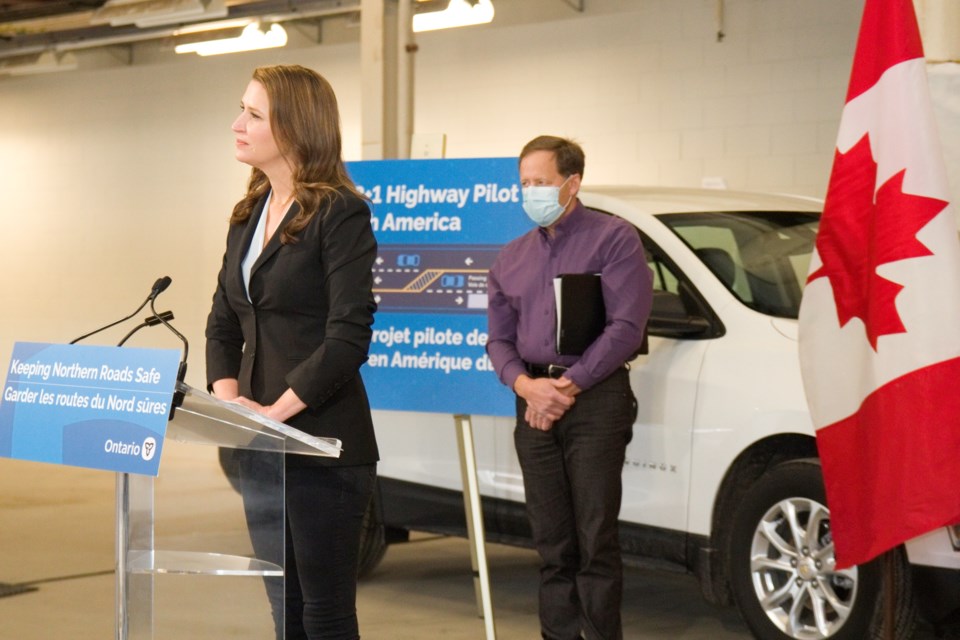This afternoon, Ontario’s Minister of Transportation, Caroline Mulroney, arrived at North Bay’s Ontario Government Building on McKeown Ave. to announce the 2 + 1 highway project has been approved.
“Our government is moving forward with the first ever 2 + 1 highway pilot in North America,” Mulroney enthused, noting the road, once complete, will improve safety for drivers.
Mulroney emphasized “road safety will always be my top priority as Minister of Transportation, especially here in Northern Ontario, where driving can be especially challenging.”
What is a 2 + 1 highway? Imagine a two-lane highway, with the addition of a third lane every three to five kilometres to provide room to pass. Sound familiar? Now add a median running down the centre line to ensure those two lanes remain separate.
The median cuts out passing except for in those designated third lane stretches. “It makes drivers do the right thing,” said Mark Wilson, a member of Going the Extra Mile for Safety (GEMS), a Temiskaming-based road safety advocacy group.
Wilson and his colleagues have been working since 2016 to implement the 2 + 1 highway to improve safety on Highway 11 North.
GEMS launched in March of 2016, and before that, The Next 100 Miles group, spearheaded by the Temiskaming Shores and Area Chamber of Commerce, was the main advocacy group.
At first the focus was to turn Highway 11 from North Bay to Temiskaming Shores into four lanes. The high costs of the project destroyed that dream.
Undeterred, and driven to improve safety and prevent needless deaths, GEMS forged on, looking for alternate solutions that the government would consider funding.
Their quest for solutions led them to the 2 + 1 road system, which was developed in Sweden, and has been adopted in Ireland, Australia, Finland, Germany, and other countries.
See: Provincial working group formed to study 2+1 highway system for the north
Is it safer? Yes. The Transportation Research Board—a division of the National Academy of Sciences, Engineering, and Medicine—found fatalities decreased by 50 per cent on 2+1 roads.
“Looking only at links (excluding intersections), the number of fatalities and seriously injured decreased by 63 per cent,” their report concludes.
“The key message here is about safety,” Mark Wilson emphasized. “Lives are saved by a median barrier.”
“Our government is thinking differently, and acting boldly to protect drivers because every incident and every life lost on our roads is one too many,” Mulroney added,
However, these bold actions will take a while, as the Minister anticipates a three to four year wait to build the road.
In the meantime, the Ministry wants your feedback as to where this pilot project will go.
Two options exist. The first is Highway 11 from Sand Dam Road to Ellesmere Road, which is about 14 kilometres.
The second option is also on Highway 11, a 16-kilometre stretch from Highway 64 to Jumping Caribou Lake Road.
Each kilometre is estimated to cost between one and three million dollars, Mulroney noted.
To have your say into the matter, visit the Ministry of Transportation’s technical consultation portal and leave your thoughts, as they will be seeking input until January 11, 2022.
“Before we choose a location, we want your feedback,” Mulroney emphasized.
“Our PC government is embracing innovative solutions in building new roads, highways and transit that will ensure our economy continues to grow, thrive, and remain globally competitive.”
“This investment is an important step to show Northern Ontarians that our safety matters,” said North Bay’s Mayor, Al McDonald.
“We will no longer accept these tragic road deaths as inevitable,” Wilson added, “and we will begin an era of safer roads in Ontario.”
And for GEMS, this means more 2 + 1 roadways— “the future of northern highways.”
David Briggs is a Local Journalism Initiative reporter who works out of BayToday, a publication of Village Media. The Local Journalism Initiative is funded by the Government of Canada.
